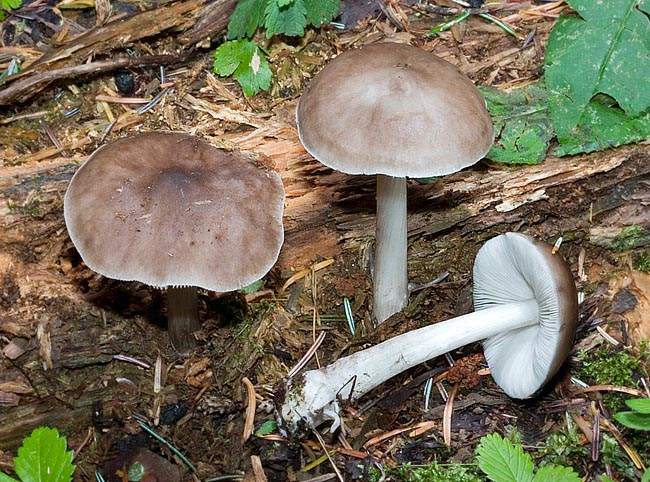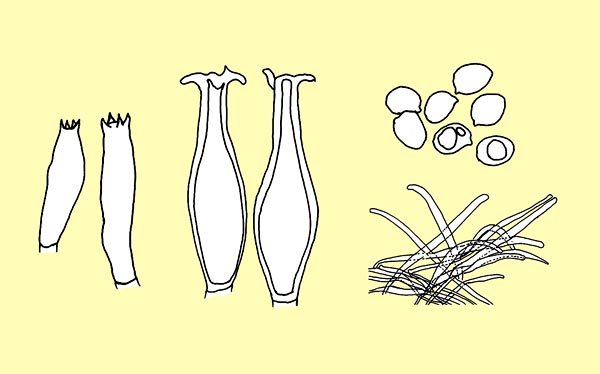
Text © Pierluigi Angeli

English translation by Mario Beltramini

Common on decaying wood, Pluteus cervinus is a poor valued edible © Giuseppe Mazza
Family: Pluteaceae Kotlaba & Pouzar, 1972.
Genus: Pluteus Fries, 1836.
Section: Pluteus.
Pluteus cervinus (Schaeffer) P. Kummer, 1871.
The etymology of the name comes from “cervinus”, relevant to the deer, due to its colour.
It is a fairly common species but little known as edible mushroom, even if not much attractive, and therefore its common names are not many.
In Italy it is known as “pluteo cervino”; in France under the common name of “Plutée couleur de cerf” and “Plutée de cerf”; in Spain as “plúteo cervino”; in England as “Fawn agaric”; in Germany as “Rehbrauner Dachpilz”, “Hirschbrauner Dachpilz”; in USA as “Fawn pluteus”.
Description of Genus and Section
To the genus Pluteus are ascribed heterogenous fungi, of small to medium-big size, lignicolous. The cap is convex to convex campanulate, at times with a blunt umbo; fibrillose surface, squamulose, pruinose, rugulose at the disk at times; smooth or striated. Thick gills, free of the stem, white to yellow at times, to salmon pink by the end. The stem is central, cylindrical, glabrous, pruinose-floccose, without ring and without volva. Smooth spores, inamyloid, subglobose to amply ellipsoidal, ovoid, pink in mass, pleurocystidia and cheilocystidia are present, in some species they have thick wall and hooked apex, the clamp connections are present or not.
To the section Pluteus are ascribed species presenting abundant pleurocystidia, with thick wall and apex hooked by 2-3 or 4 pointed hooks; pileipellis with filamentous, radial, tapered-elongated hyphae, clamp connections present or absent.
Description of the species
Cap: 4-10 cm, fleshy, initially bell-shaped, then convex and finally almost flat, umbonate, smooth, glabrous, at times with radial fibrils, greasy to the touch; the cuticula, easily detachable, goes from grey-brown to ocherous-brown, darker at the centre and paler at the margin, this last being smooth.

Basidia, pleurocystidia, spores and pileipellis of Pluetus cervinus © Pierluigi Angeli
Hymenium: thick gills, ventricose, free, intercalated by rounded lamellulae of various length, white to pink-salmon, floccose thread.
Stem: crowded gills, ventricose, free, intercalated by rounded lamellulae of various lengths, white to pink-salmon, floccose thread.
Flesh: white, thick, compact, becomes soft when ripe, fibrous in the stem, radish smell, taste almost absent.
Habitat: it grows from spring to autumn on dead wood of latifoliate trees, more rarely on conifers.
Edibility: edible, but of little value.
Microscopy: smooth spores, slightly ellipsoidal, 8-9 × 5,5-6 µm. Cylindrical basidia, ventricose, 25-40 × 8,75-9,5 µm. Smooth cystidia, bottle-shaped, with thick wall, hooked apex, 67,5-82,5 × 15-21 µm. Clamp connections are absent.
Remarks: It is a much diffused fungus, both in the plains and in the mountains on dead wood, at times even interred. The correct determination of the species belonging to the section Pluteus may be obtained by means of an accurate microscopic investigation, that is, on the presence/absence of the clamp connections. However, from the last studies it results the presence or not of the clamp connections is not sufficient any more, as a matter of fact, it is necessary to verify, if they are present, where they are located and their frequency. Pluteus cervinus can be mistaken with Pluteus pouzarianus Singer, which is practically a lookalike, but presents the clamp connections at the base of the basidia and very frequent in the texture of the cuticle.
Very similar are also Pluteus brunneoradiatus Bonnard, which, however, has the clamp connections at the base of the basidia; Pluteus primus which however has the clamp connections at the base of the basidia as well as in the pileipellis. Another species which might be mistaken with Pluteus cervinus is Pluteus atromarginatus (Konrad) which, however, grows on old trunks of needle leaved trees, has dark brown lamellar thread and the clamp connections are absent.
Synonyms: Agaricus cervinus Schaeffer 1774 (basionym), Agaricus atricapillus Batsch 1786, Pluteus atricapillus (Batsch) Fayod 1889, Agaricus pluteus Batsch 1783, Hyporrhodius cervinus (Schaeffer) Hennings 1898.
→ For general notions about Fungi please click here.
→ To appreciate the biodiversity of MUSHROOMS please click here.
